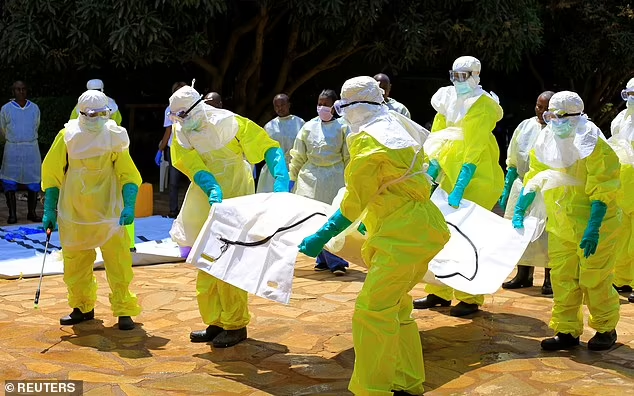- Courses
- GS Full Course 1 Year
- GS Full Course 2 Year
- GS Full Course 3 Year
- GS Full Course Till Selection
- Answer Alpha: Mains 2025 Mentorship
- MEP (Mains Enrichment Programme) Data, Facts
- Essay Target – 150+ Marks
- Online Program
- GS Recorded Course
- Polity
- Geography
- Economy
- Ancient, Medieval and Art & Culture AMAC
- Modern India, Post Independence & World History
- Environment
- Governance
- Science & Technology
- International Relations and Internal Security
- Disaster Management
- Ethics
- NCERT Current Affairs
- Indian Society and Social Issue
- NCERT- Science and Technology
- NCERT - Geography
- NCERT - Ancient History
- NCERT- World History
- NCERT Modern History
- CSAT
- 5 LAYERED ARJUNA Mentorship
- Public Administration Optional
- ABOUT US
- OUR TOPPERS
- TEST SERIES
- FREE STUDY MATERIAL
- VIDEOS
- CONTACT US
What is Disease X?
What is Disease X?
13-12-2024

- In December 2024, the Democratic Republic of Congo reported a mysterious outbreak that has claimed over 400 lives. Although the disease remains unidentified, experts suspect it could be an instance of Disease X.
- Disease X is not an actual disease but a hypothetical one. The World Health Organization (WHO) introduced the term in 2018 to represent an unknown pathogen with the potential to cause a severe epidemic or pandemic.
What is WHO’s Priority List of Pathogens?
- The WHO’s focus on Disease X gained traction after the West African Ebola epidemic of 2014–2016, which claimed over 11,000 lives and exposed critical gaps in global epidemic preparedness.
- COVID-19 is widely seen as the 1st real instance of Disease X. The emergence of SARS-CoV-2 as an unknown pathogen that triggered a global pandemic.
- In 2018, the WHO published a priority list of pathogens to direct global attention and resources toward the most critical infectious disease threats.
- The list prioritises diseases with epidemic or pandemic potential that lack adequate medical countermeasures like vaccines or treatments.
- Objective: To guide research and development, allocate resources effectively and strengthen global preparedness. This list aids policymakers, researchers, and health organisations in prioritising efforts to combat these diseases.
- Current Pathogens on the List: Ebola virus disease, Marburg virus disease, Lassa fever, Nipah virus, Rift Valley fever, Crimean-Congo haemorrhagic fever, Zika virus, Disease X
- These pathogens are prioritised due to factors such as high mortality rates, rapid transmission potential, and inadequate preventive or treatment options.
What is Disease X?
- It is not a specific disease but a placeholder for an unknown pathogen capable of causing a global health crisis.
- The WHO incorporated it into its Blueprint for Priority Diseases in 2018 to prepare for the risks posed by emerging, unidentified diseases.
- Disease X lies at the intersection of “known unknowns” (threats we know exist but cannot fully predict) and “unknown unknowns” (completely unanticipated threats).
- Potential Sources: Disease X could emerge from various agents - Viruses, Bacteria, Parasites, Fungi, Helminths, Prions (misfolded proteins causing neurological diseases)
- Unpredictability: Since 1940, over 300 emerging infectious diseases have been identified, with around 70% originating from zoonotic spillover (transmission from animals to humans).
- Factors contributing to zoonotic spillover include: human encroachment on wildlife habitats, deforestation, intensified agricultural practices.
- Additional risks include antimicrobial resistance, bioterrorism (deliberate release of bioweapons to cause death or disease in humans, animals, or plants), and accidental laboratory leaks, adding further uncertainty.
Are There Any Patterns in Emerging Diseases?
- Previous viruses like HIV, SARS, MERS, and Ebola have been closely tied to ecological disruptions caused by humans.
- Human-induced changes like deforestation, urbanisation, and climate change have brought humans and wildlife closer together, increasing the chances of disease transmission.
- Epidemiologists estimate that over 1.7 million undiscovered viruses exist in wildlife, with hundreds of thousands of them potentially able to infect humans.
- The occurrence of new outbreaks has risen significantly since the mid-20th century, driven by environmental, demographic, and global factors.
- Areas with high biodiversity and poor healthcare systems, such as the Congo Basin, are at greater risk. The ease of international travel and trade helps local outbreaks to escalate into pandemics, as seen with COVID-19.
- While epidemiology cannot predict the exact time or source of Disease X, it helps identify regions and behaviours that increase its chances of emerging.
What are the Challenges in Predicting Disease X?
- Unpredictable Factors: Predicting the next Disease X is challenging because its emergence depends on various unpredictable factors. Zoonotic diseases are the most likely origin, given their role in past epidemics.
- However, other possibilities, such as pathogens evolving to avoid treatment, lab accidents, or intentional biological attacks, cannot be excluded.
- Climate change is also altering how diseases spread, expanding the reach of vector-borne illnesses like malaria and dengue fever while pushing pathogens to adapt to new hosts and environments.
- Unidentified Pathogens: Only a small fraction of viruses that can infect humans have been discovered, leaving many potential threats undiscovered.
- Role of Technology: Genomic sequencing and artificial intelligence are becoming crucial in identifying and narrowing down potential threats. However, predicting the exact origin, timing, and characteristics of Disease X is still beyond reach.
What Preparations need to be done for Disease X?
- Robust surveillance systems are essential for early detection. Advances in genomic sequencing, artificial intelligence, and real-time data sharing are vital for developing diagnostics, treatments, and vaccines.
- Strengthening healthcare infrastructure, especially in low- and middle-income countries, is also critical.
- Proactive Investments: Organisations like the Coalition for Epidemic Preparedness Innovations (CEPI) are working on "prototype pathogen" platforms that can be quickly adapted to tackle unknown diseases within 100 days of identification.
- Need for Global Collaboration: Key efforts by the World Health Organization (WHO), such as the priority pathogens list and the proposed Pandemic Treaty, are designed to promote a unified global response to health crises.
- Frameworks like the Nagoya Protocol, which ensures the fair sharing of benefits from genetic resources, could be adapted to include biological materials such as pathogens.
Initiatives to Combat Disease X
|
Global Efforts |
Indian Efforts |
|
|



